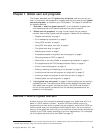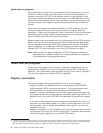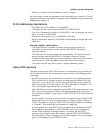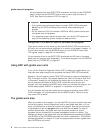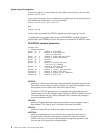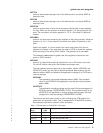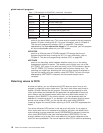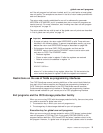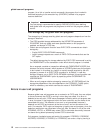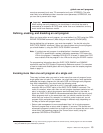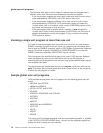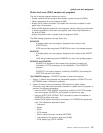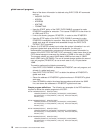
Table 1. TCB indicators in DFHUEPAR (continued). Description
Symbolic
value
2-byte
code
Description
UEPTRP RP The ONC/RPC mode TCB
UEPTSZ SZ The FEPI mode TCB
UEPTJ8 J8 The JVM mode TCB
UEPTL8 L8 An open mode TCB
UEPTSL SL The sockets listener mode TCB
UEPTSO SO The sockets mode TCB
UEPTS8 S8 The secure sockets layer mode TCB
UEPSTACK
points to the kernel stack entry. This value must be moved to the exit program’s
register 13 before invoking the XPI. For more information, refer to “Chapter 3.
The user exit programming interface (XPI)” on page 283. The storage
addressed by this field must not be altered. If it is corrupted, your exit program
will have unpredictable effects on your CICS system.
UEPXSTOR
points to a 320-byte area of DFHUEH-owned LIFO storage that the exit
program should use when invoking the XPI. For more information, refer to
“Chapter 3. The user exit programming interface (XPI)” on page 283.
UEPTRACE
points to the trace flag, which indicates whether tracing is on in the calling
management module or domain. This enables you to control your use of the
XPI TRACE_PUT macro in line with the tracing in the CICS module or domain.
The XPI TRACE_PUT function should be used only when tracing is on. The
trace flag is a single byte, whose top bit is set on when tracing is switched on.
You test this setting using the symbolic value UEPTRON. The rest of the byte
addressed by UEPTRACE is reserved, and its contents should not be
corrupted.
Returning values to CICS
At some exit points, you can influence what CICS does on return from an exit
program by supplying a return code value. The return code value must be set in
register 15 before leaving the exit program. Character strings equating to valid
return code values are provided with the parameter list appropriate for each exit
point. Always use the equated values rather than using hard-coded values. For
example, at exit XMNOUT in the monitor domain, you are presented with the
address of a monitoring record. If you decide in your exit program that this record
should not be written to SMF, you can set the return code value UERCBYP
(meaning “bypass this record”) before returning to CICS, and CICS suppresses the
record.
You cannot influence CICS actions in this way at all exit points. If you supply a
return code value that is not expected at a particular exit point, the default return
code indicating a normal response (usually UERCNORM) is assumed, unless the
return code UERCPURG is set (see note below about UERCPURG). You are
strongly advised not to let the return code default to the normal response as the
result can be unpredictable. The normal response tells CICS to continue processing
global user exit programs
10
CICS TS for OS/390: CICS Customization Guide
|
|
|
|
|
|
|||
|||
|||
|||
|||
|||
|||
|
#
#
#




